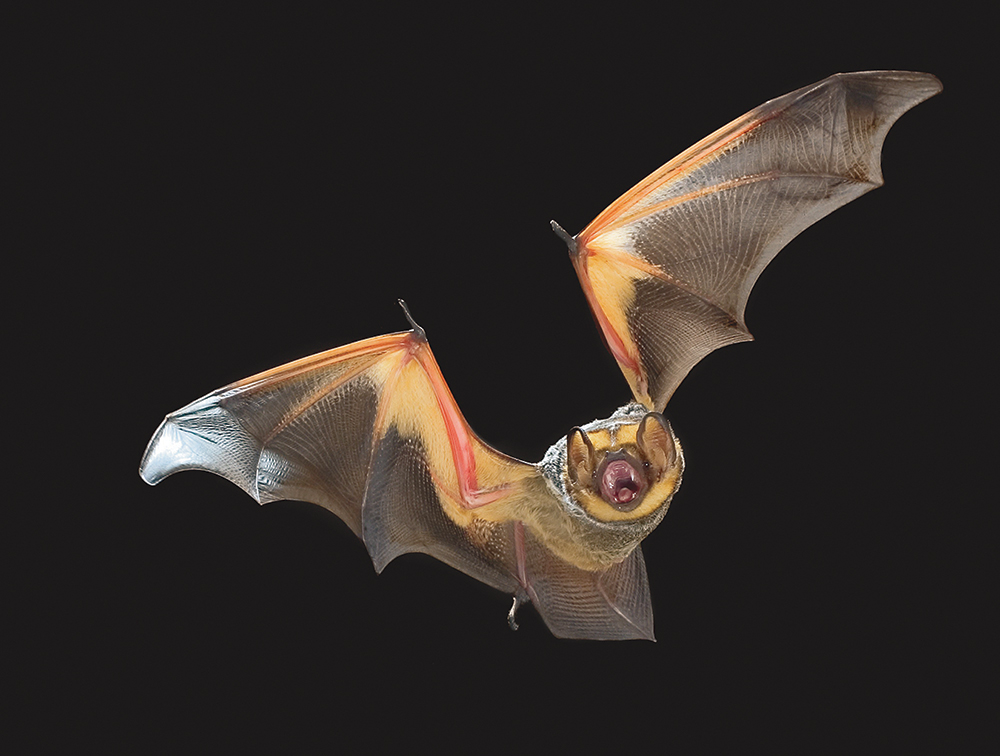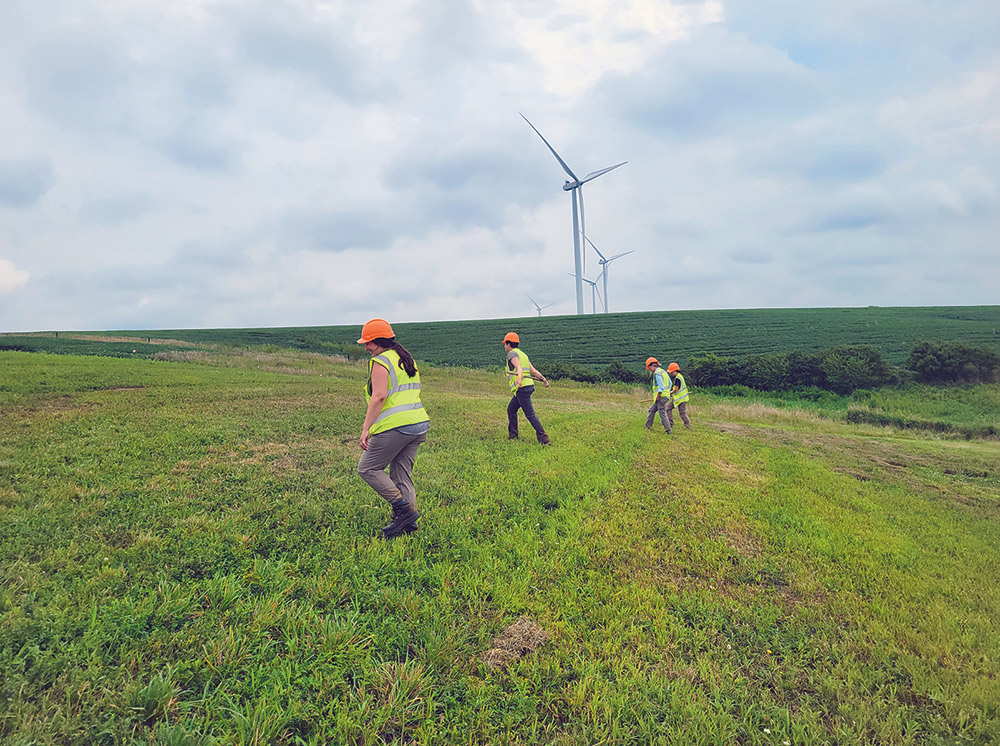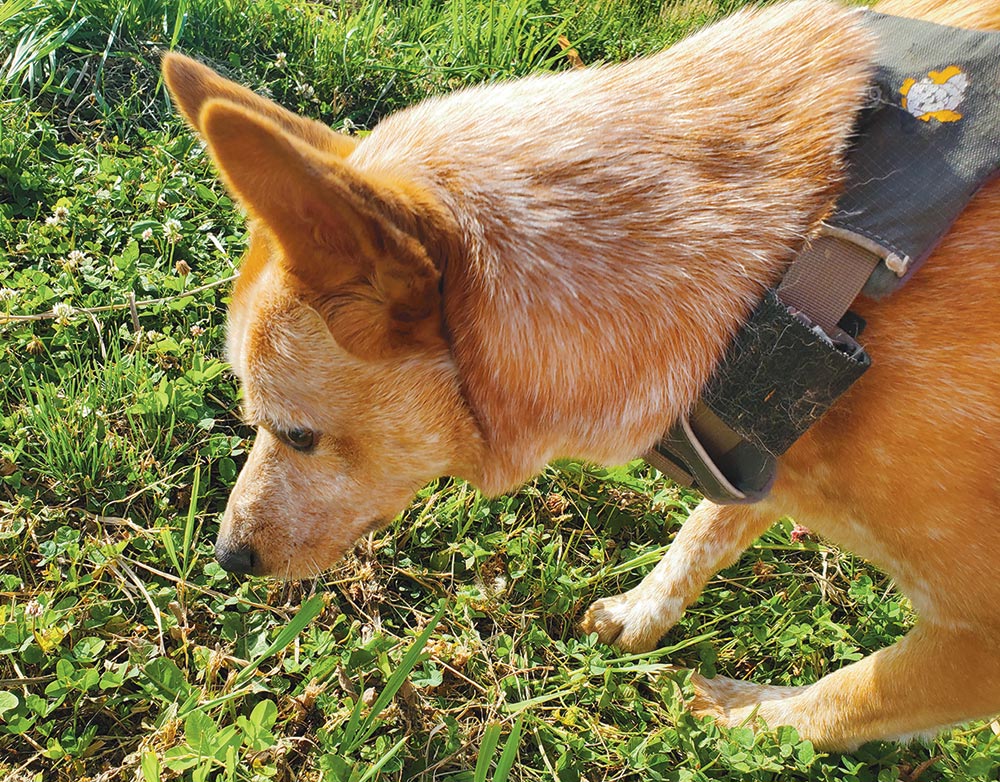 Feature: Detection Dogs
Feature: Detection DogsData Dogs

usty deserved some positive reinforcement—approving words, tasty treats, and a scratch or two behind the ears. Blitz, too, has earned praise and recognition but prefers the reward of fetching a frisbee. These dogs—Dusty, an eight-year-old female Brittany, and Blitz, a five-year-old male red cattle dog—along with their human handler, Julia Nawrocki, are on a mission to collect meaningful data that, ultimately, may save migratory bats from fatal impacts with wind turbines.
On workdays, the dogs and Nawrocki are on the road long before sunrise to drive an hour to one of Iowa’s sweeping wind energy installations. As the sun begins to rise, Nawrocki will bring one of the dogs to survey for miles under towering turbines. Meanwhile, the other dog will wait in a comfortably cooled crate and join Nawrocki later so that both dogs have plenty of time to rest and don’t get overworked.

Hoary Bats at Risk
It’s difficult to spot an animal that weighs less than an ounce. That’s why specially trained detection dogs are so important and far better than humans at finding the bats. Though the work is strenuous, the process is simple: The dogs sniff out the bat carcasses and are rewarded for their discoveries. Nawrocki records the locations of the findings so a team from Bat Conservation International (BCI) can compile the data.
—Dr. Winifred Frick
Hoary bats (Lasiurus cinereus) are one of the most widespread bat species in North America and are particularly vulnerable to colliding with the rotating blades of massive turbines in wind energy developments. Silver-haired bats (Lasionycteris noctivagans) and eastern red bats (Lasiurus borealis) are other species susceptible to the spinning blades.
The detection dog teams and researchers work with urgency. In 2021, Dr. Winifred Frick, BCI’s Chief Scientist, co-authored a scientific report published in Biological Conservation that concluded hoary bats face a rapid, staggering decline unless urgent conservation measures are taken to reduce bat fatalities at wind farms in the United States and Canada. Without intervention, hoary bats could decline a stunning 50% by the year 2028.
“Solid data, like the data collected by detection dogs, will determine how successful we are in sustaining biodiversity in North America,” Dr. Frick says.
The life of a detection dog
Nawrocki now works for the company, and she brought her own dog, Dusty, into the fold. Dusty, she says, is “full of sass” but otherwise atypical of the type of dog Rogue Detection engages. She’s a full breed, had been privately owned, and was acquired from an older man who was moving and realized his new place would be too confining. Most of the detection dogs are shelter dogs.
Rogue Detection co-founders Heath Smith and Jennifer Hartman take great pride in adopting rescue dogs, which Hartman describes as “dogs with an obsessive need to play and fetch, whose energy makes them otherwise challenging as pets in a home environment.” She calls their dogs “rascally with high energy,” but stresses that they don’t favor any particular breeds. Their website calls their rescue dogs “diamonds-in-the-ruff” as it touts their serious work around the world surveying wolves, cheetahs, spotted owls, Sierra Nevada red foxes, bumblebee nests, butterfly larvae, and bats.

Finding Solutions
Detection dogs are trained by associating odors with fun, and they are rewarded with play when they find the odor. Detection dogs are also taught a passive alert once they find an odor. They sniff and sit or go into a down position and stare when they find a specimen. Once the dog identifies the specimen associated with the odor, they’re rewarded with fetching a ball, chasing a frisbee, or playing a rope tug game.
“Of course, it takes a special kind of dog to do this work, but it also takes a special kind of person,” Hartman says. “Dog handlers are called ‘bounders’ because we’re bound to the dogs. We’re bound to the environments we’re in. And we’re bound to scientific methodology.”
Hartman stresses the point: Bounder work is not easy. Relationship building and training can take a year or more, like with K-9 and dog therapy training programs. “We learn from our dogs and how to best work with them,” she says. “We never trick them. And we always have to bring our A-game, because dogs can sense when we’re tired or hot.”
The tolls of bat detection
“Bat detection work can be very different from our other work,” Hartman says. “It can be tedious walking back and forth. Plus, it’s often done under the hot sun with no shade, and it usually requires the dog to be on a long-line leash of 10–15 feet. The work can be mentally exhausting for both the dog and the bounder.

Michael Whitby is Director of BCI’s Bats and Wind Energy program, and he also has personal ties to the world of detection dogs—Nawrocki is his partner, and Dusty is one of the family dogs. Whitby says counting bat fatalities and analyzing this data is crucial to reduce the alarming increase in bat mortalities related to wind energy facilities.
—Jennifer Hartman